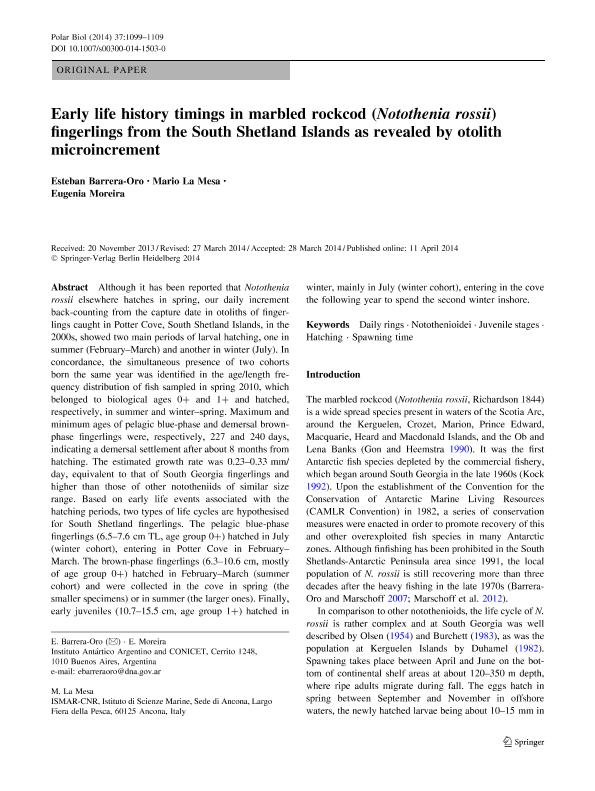Mostrar el registro sencillo del ítem
dc.contributor.author
Barrera Oro, Esteban

dc.contributor.author
La Mesa, Mario
dc.contributor.author
Moreira, María Eugenia

dc.date.available
2018-01-12T19:06:31Z
dc.date.issued
2014-04
dc.identifier.citation
Moreira, María Eugenia; La Mesa, Mario; Barrera Oro, Esteban; Early life history timings in marbled rockcod (Notothenia rossii) fingerlings from the South Shetland Islands as revealed by otolith microincrement; Springer; Polar Biology; 37; 8; 4-2014; 1099-1109
dc.identifier.issn
0722-4060
dc.identifier.uri
http://hdl.handle.net/11336/33115
dc.description.abstract
Although it has been reported that Notothenia rossii elsewhere hatches in spring, our daily increment back-counting from the capture date in otoliths of fingerlings caught in Potter Cove, South Shetland Islands, in the 2000s, showed two main periods of larval hatching, one in summer (February–March) and another in winter (July). In concordance, the simultaneous presence of two cohorts born the same year was identified in the age/length frequency distribution of fish sampled in spring 2010, which belonged to biological ages 0+ and 1+ and hatched, respectively, in summer and winter–spring. Maximum and minimum ages of pelagic blue-phase and demersal brown-phase fingerlings were, respectively, 227 and 240 days, indicating a demersal settlement after about 8 months from hatching. The estimated growth rate was 0.23–0.33 mm/day, equivalent to that of South Georgia fingerlings and higher than those of other nototheniids of similar size range. Based on early life events associated with the hatching periods, two types of life cycles are hypothesised for South Shetland fingerlings. The pelagic blue-phase fingerlings (6.5–7.6 cm TL, age group 0+) hatched in July (winter cohort), entering in Potter Cove in February–March. The brown-phase fingerlings (6.3–10.6 cm, mostly of age group 0+) hatched in February–March (summer cohort) and were collected in the cove in spring (the smaller specimens) or in summer (the larger ones). Finally, early juveniles (10.7–15.5 cm, age group 1+) hatched in winter, mainly in July (winter cohort), entering in the cove the following year to spend the second winter inshore.
dc.format
application/pdf
dc.language.iso
eng
dc.publisher
Springer

dc.rights
info:eu-repo/semantics/openAccess
dc.rights.uri
https://creativecommons.org/licenses/by-nc-sa/2.5/ar/
dc.subject
Daily Rings
dc.subject
Notothenioidei
dc.subject
Juvenile Stages
dc.subject
Hatching
dc.subject
Spawning Time
dc.subject.classification
Otras Ciencias Biológicas

dc.subject.classification
Ciencias Biológicas

dc.subject.classification
CIENCIAS NATURALES Y EXACTAS

dc.title
Early life history timings in marbled rockcod (Notothenia rossii) fingerlings from the South Shetland Islands as revealed by otolith microincrement
dc.type
info:eu-repo/semantics/article
dc.type
info:ar-repo/semantics/artículo
dc.type
info:eu-repo/semantics/publishedVersion
dc.date.updated
2018-01-11T13:48:30Z
dc.identifier.eissn
1432-2056
dc.journal.volume
37
dc.journal.number
8
dc.journal.pagination
1099-1109
dc.journal.pais
Alemania

dc.journal.ciudad
Berlín
dc.description.fil
Fil: Barrera Oro, Esteban. Ministerio de Relaciones Exteriores, Comercio Interno y Culto. Dirección Nacional del Antártico. Instituto Antártico Argentino; Argentina. Consejo Nacional de Investigaciones Científicas y Técnicas; Argentina
dc.description.fil
Fil: La Mesa, Mario. Consiglio Nazionale delle Ricerche. Istituto Di Scienze Marine; Italia
dc.description.fil
Fil: Moreira, María Eugenia. Ministerio de Relaciones Exteriores, Comercio Interno y Culto. Dirección Nacional del Antártico. Instituto Antártico Argentino; Argentina. Consejo Nacional de Investigaciones Científicas y Técnicas; Argentina
dc.journal.title
Polar Biology

dc.relation.alternativeid
info:eu-repo/semantics/altIdentifier/url/https://link.springer.com/article/10.1007%2Fs00300-014-1503-0
dc.relation.alternativeid
info:eu-repo/semantics/altIdentifier/doi/http://dx.doi.org/10.1007/s00300-014-1503-0
Archivos asociados
